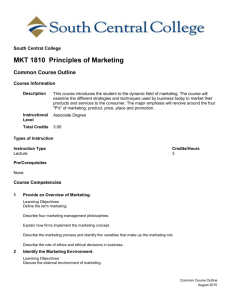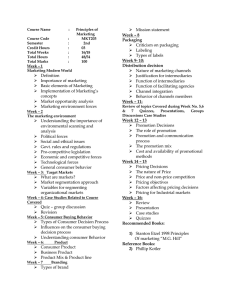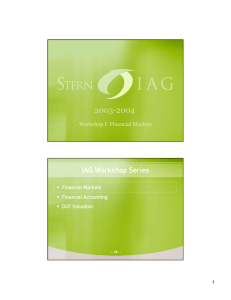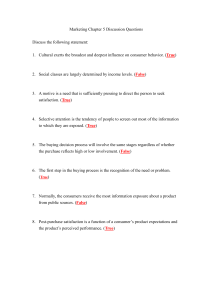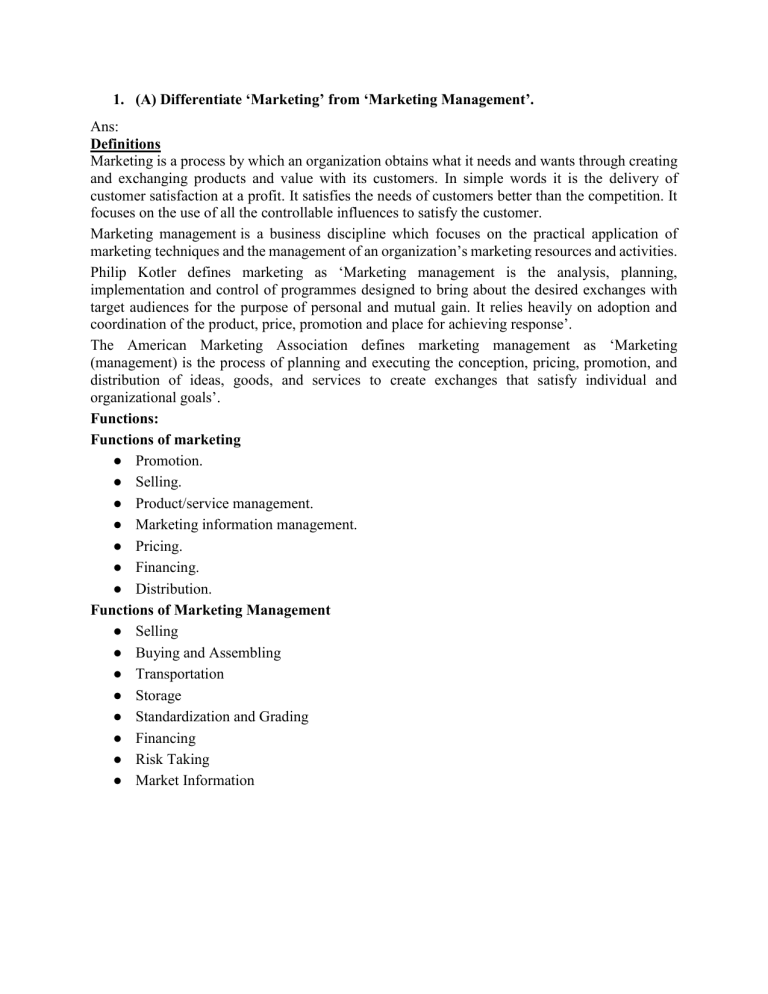
1. (A) Differentiate ‘Marketing’ from ‘Marketing Management’. Ans: Definitions Marketing is a process by which an organization obtains what it needs and wants through creating and exchanging products and value with its customers. In simple words it is the delivery of customer satisfaction at a profit. It satisfies the needs of customers better than the competition. It focuses on the use of all the controllable influences to satisfy the customer. Marketing management is a business discipline which focuses on the practical application of marketing techniques and the management of an organization’s marketing resources and activities. Philip Kotler defines marketing as ‘Marketing management is the analysis, planning, implementation and control of programmes designed to bring about the desired exchanges with target audiences for the purpose of personal and mutual gain. It relies heavily on adoption and coordination of the product, price, promotion and place for achieving response’. The American Marketing Association defines marketing management as ‘Marketing (management) is the process of planning and executing the conception, pricing, promotion, and distribution of ideas, goods, and services to create exchanges that satisfy individual and organizational goals’. Functions: Functions of marketing ● Promotion. ● Selling. ● Product/service management. ● Marketing information management. ● Pricing. ● Financing. ● Distribution. Functions of Marketing Management ● Selling ● Buying and Assembling ● Transportation ● Storage ● Standardization and Grading ● Financing ● Risk Taking ● Market Information 1. B) What are the differences among marketing concept, production concept, product concept, and selling concept? Which concepts are easier to adopt in the short-run? Ans: Production concept – It is one of the oldest concepts which guides sellers. The production concept holds that customers favour those products that are widely available and low in cost. Production oriented organizations concentrate on achieving high production efficiency and wide distribution coverage. This concept holds in at least two types of situations. The first is where the demand for a product exceeds supply. Here consumers are more interested in obtaining the product than in its fine points. The suppliers will concentrate on finding ways to increase production. The second situation is where the product’s cost is high and has to be brought down through increased productivity to expand the market. ● Product concept – This concept holds that customers favour those products that offer quality or performance. Product oriented organizations focus their energy on making good products and improving them over time. In this concept it is assumed that buyers admire well made product and can appraise product quality and performance. These organizations are caught up in an appreciation of their product and fail to appreciate that the market may be less ‘turned on’ and may be even moving in different direction. The product concept leads to ‘marketing myopia’, an undue concentration on the product rather than the need. ● Selling concept – This concept assumes that customers, if left alone, will not buy enough of the organization’s products. The organization must therefore carry out an aggressive selling and promotion effort. The concept assumes that customers show buying inertia or resistance and have to be coaxed into buying more, and that the organization has available a whole battery of effective selling and promotion tools to stimulate more buying. The selling concept is practiced most aggressively with ‘sought products’, those products that buyers normally do not think of buying. Under this concept organization perfects various sales techniques to locate prospective customers and hard sell them on the benefits of their product. Most organizations practice the selling concept when they have overcapacity. Their aim is to sell what they make rather than make what they can sell. Thus selling, to be effective, must be preceded by several marketing activities such as needs assessment, marketing research, product development, pricing, and distribution. If the organization does a good job of identifying customer needs, developing appropriate products, and pricing, distributing, and promoting them effectively, these products will sell very easily. Indeed, marketing based on hard selling carries high risks. It assumes that customers who are coaxed into buying the product will like it; and if they don’t, they won’t bad-mouth it to friends or complain to other customers and they will possibly forget their disappointment and buy it again. These are indefensible assumptions to make about buyers. One study showed that disappointed customers bad mouth the product to eleven acquaintances, while satisfied customers may good mouth the product to only three. ● Marketing concept – This concept holds that the key for the achievement of the organizational goals. It consists in determining the needs and wants of target markets and delivering the desired satisfactions more effectively and efficiently than competitors. Selling focuses on the needs of the seller while marketing focuses on the needs of the customer. Selling is preoccupied with the seller’s need to convert his product into cash ● while marketing believes with the idea of satisfying the needs of the customer by means of the product and the whole cluster of things associated with creating, delivering and finally consuming it. Hence market focus is important. No organization can operate in every market and satisfy every need. Nor can it even do a good job within one broad market. An organization can do best when it defines its target markets carefully. It can do best when it prepares a tailored marketing program for each target market. Short run Marketing Among all the six concepts of marketing the easier concept to adopt in short run is the selling concept. The selling concept is practiced most aggressively with unsought goods, goods that buyers do not think of buying, such as insurance, funeral plots etc. These industries have practiced various sales techniques to locate prospects and hard sell them on their products benefits. Most organization practice selling concept when they have overcapacity. Their aim is to sell what they make rather than make what the market wants. In most modern industrial economics, productivity capacity has been built up to a point where the most markets are buyer markets (the buyers are dominant) and sellers have to scramble for customer. The selling concept does not consider what the customer wants, what is the quality of the product. They believe in push selling. They believe customer will buy the product if they always pushed to buy it. Marketing based on hard selling or selling through pushing customer carries high risks. It assumes in selling concept that customer who are coaxed into buying a product will like it; and that if they do not, the y will not bad-mouth it or complain to consumer organizations and will forget their disappointment and buy it again. These are indefensible assumptions. Study showed that dissatisfied customers may bad-mouth the product to ten or more acquaintances; and today bad news travels faster and further with the internet. So these are the reason for why selling concept for short term. It will be so tough to push sell a product for a long period in the time of communications super highway. 1. C) Pick the consumer product ‘Wrist-Watch’. Design your marketing strategy, describing the steps in the marketing process starting with defining the ‘market segment’, then explaining the designing of the ‘Four Ps’ in Marketing and ending with the ultimate objectives of marketing. Ans: In this first case we deal with a relatively simple mode of segmentation analysis. The most productive way of analyzing the market for watches turns out to be segmentation by value. This approach discloses three distinct segments, each representing a different value attributed to watches by each of three different groups of consumers: 1. People who want to pay the lowest possible price for any watch that works reasonably well. If the watch fails after six months or a year, they will throw it out and replace it. 2. People who value watches for their long life, good workmanship, good material, and good styling. They are willing to pay for these product qualities. 3. People who look not only for useful product features but also for meaningful emotional qualities. The most important consideration in this segment is that the watch should suitably symbolize an important occasion. Consequently, fine styling, a well-known brand name, the recommendation of the jeweler, and a gold or diamond case are highly valued. In 1962, my research shows, the watch market divided quantitatively as follows: ● ● ● Approximately 23% of the buyers bought for lowest price (value segment #1). Another 46% bought for durability and general product quality (value segment #2). And 31% bought watches as symbols of some important occasion (value segment #3). Defining and quantifying such segments is helpful in marketing planning—especially if a watch company’s product happens to appeal mostly to one segment or if the line straddles the three segments, failing to appeal effectively to any. Without such an understanding, the demographic characteristics of the market are most confusing. It turns out, for example, that the most expensive watches are being bought by people with both the highest and the lowest incomes. On the other hand, some upper income consumers are no longer buying costly watches, but are buying cheap, well-styled watches to throw away when they require servicing. Other upper income consumers, however, continue to buy fine, expensive watches for suitable occasions. Timex’s Timely Tactics. The planning implications in value segmentation are very broad for the industry. For one thing, many of the better watch companies in the years between 1957 and 1962 were inadvertently focusing exclusively on the third segment described—the 31% of the market that bought a watch only as a gift on important occasions—thus leaving the bulk of the market open to attack and exploitation. The U.S. Time Company took advantage of this opening and established a very strong position among the more than two-thirds of America’s watch buyers in the first two segments. Its new lowprice watch, the Timex, had obvious appeal for the first segment, and it catered to the second segment as well. At that time, higher-price watches were making the disastrous mistake in their advertising of equating product quality with water-proof and shock-resistant features. The Timex also offered these low-cost features, at lower prices, thus striking at a vulnerable area which the competition itself created. When Timex pressed its attack, it was able within a few years to claim that “Timex sells more watches than any other watch company in the world.” Even the timing of Timex’s watch advertising was involved. Much of the third segment was buying watches only during the Christmas season, and so most of Timex’s competitors concentrated their advertising in November and December. But since buying by the other two segments went on all the time, Timex advertised all year-round, getting exclusive attention ten months of the year. Thus, nondemographic segmentation in the watch industry has directly affected almost every phase of marketing, including the composition of the product line. Major watch companies know that they must plan product line, pricing, advertising, and distribution within the framework of the three basic value segments of this market. 2. (a) What are the primary differences between products and services? Give illustrations of marketing offers that highlight these differences. Ans: Product marketing Service marketing Meaning Product marketing refers to the process in which the marketing activities are aligned to promote and sell a specific product for a particular segment. Marketing mix 4 P’s: Product, Price, Place, Promotion Sells Value Relationship Who comes to whom? Products come to customers Customers come to service Transfer It can be owned and resold to another party. It is neither owned nor transferred to another party. Returnability Products can be returned. Services cannot be returned after they are rendered. They are tangible, so customer can see and touch it, before coming to the Tangibility buying decision. Product and the company producing it, Separability are separable. Products cannot be customised as per Customization requirements. Service marketing implies the marketing of economic activities, offered by the business to its clients for adequate consideration. 7 P’s: 4 P’s + People, Process, Physical evidence They are intangible, so it is difficult to promote services. Service cannot be separated from its provider. Services vary from person to person, they can be customised. Imagery They are imagery and hence, receive quick response from customers. They are non-imagery and do not receive quick response from customers. Quality comparison Quality of a product can be easily measured. Quality of service is not measurable. 2. (b) Discuss the elements of marketing mix in service marketing. Ans: What is Service Marketing Mix? The service marketing mix is a combination of the different elements of services marketing that companies use to communicate their organizational and brand message to customers. The mix consists of the seven P’s i.e. Product, Pricing, Place, Promotion, People, Process and Physical Evidence. The service marketing mix, also known as the extended marketing mix, treats the service that the business offers just as it would treat a product. While the first four P’s are involved in product marketing too, the remaining three P’s focus mainly on service delivery and enhancing customer satisfaction. Elements of Service Marketing Mix 1. Product – Unlike a product, a service is intangible and cannot be measured in terms of look, feel and other qualities present in a commodity. However, it can be customized to suit the user requirements and give a personal touch. However, the service product is heterogeneous and perishable in nature just like a normal product and needs to be designed with the utmost care to increase customer satisfaction. 2. Pricing – The pricing strategy for services is difficult to achieve unlike in products, wherein the final price depends on the raw materials, cost of production and distribution etc. However, in service pricing, you cannot measure the cost of the services you offer that easily. For example, in the education industry, how would you set the price of the quality of education imparted? Or if you are in the food and hospitality industry, how would you charge the customers for the care shown by the host or hostess, the ambience in the restaurant or the fine taste of your delicacies? Therefore, pricing plays a crucial role in the services marketing mix for your business. 3. Place – The place where you choose to conduct your service business can make or break your organizational growth. You need to understand how visible your setup would be to potential customers and how frequently it would be visited by consumers. For example, would you set up a fast-food centre near a college or office hub, where students and professionals can quickly grab a bite or next to a big restaurant in a classy neighbourhood? 4. Promotion – The service industry usually has stiff competition across different verticals and your business would need a lot of promotions to pass on the right message to potential customers. While advertising, online and direct marketing are the best ways to promote your service you need to have a good mix of communication channels to address a larger audience. 5. People – Your business is not just built on your goals, company vision and principles but also depends heavily on your employees. It is the people who work for you who are responsible in creating happy and returning customers. People in your organization are the epicentre of the quality of your services and need to have the best of talents to gain customer loyalty and trust. 6. Process – How efficiently your services are delivered to the customer is an important aspect of your service blueprint and you need to emphasize on setting up a process for doing so. You need to ask yourself “Do I want to have a process in place that is quick, reliable and easy to monitor or one that is sluggish but necessarily passes through several layers of hierarchy?” In today’s competitive world, companies are always in the race to deliver services quickly, efficiently and with the highest quality. 7. Physical Evidence – While offering your services, you can either do it without adding a personal touch or by differentiating your offerings by adding an element of delight to the customer. For example, would you prefer to visit a bookstore that only has a stack of books with a cashier nearby or one that also has a place to sit, where you can browse through the book you are interested in and enjoy the light music in the backdrop while you make a choice? The ambience of a bookstore or restaurant, the music, the friendly face of your travel host etc. are all part of the physical evidence of a service and they are an important element of the service marketing mix. The services sector has various kinds of businesses catering to the needs of individual consumers or bigger enterprises and larger businesses. Whatever industry domain you conduct your business in ensure to create the right service marketing mix for better customer satisfaction. 2. C) Explain the implication of service characteristics in designing a marketing strategy. Ans: Services have four major characteristics that greatly affect the design of marketing programs: ● ● ● ● ● Intangibility. Variability. Inseparability. Resulting Marketing Implications. Perishability.
